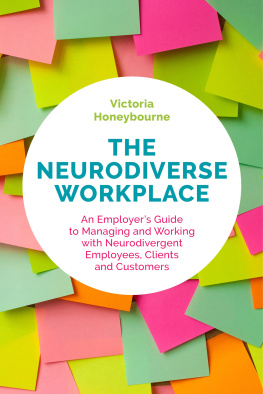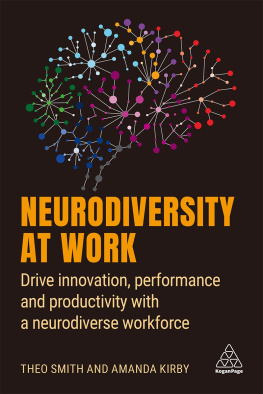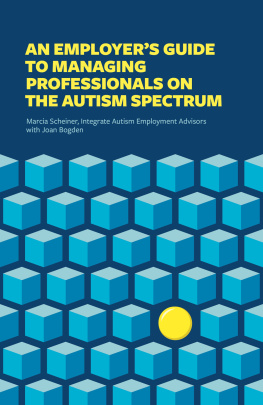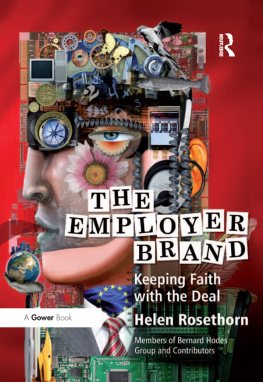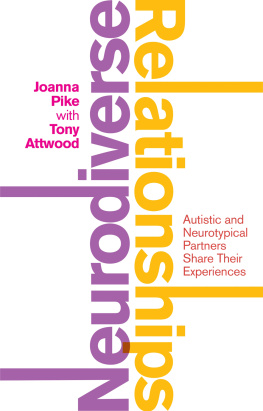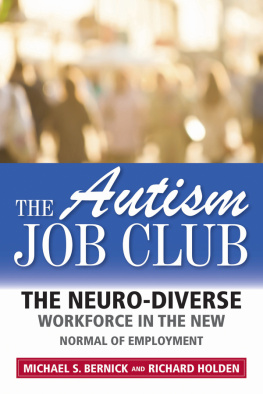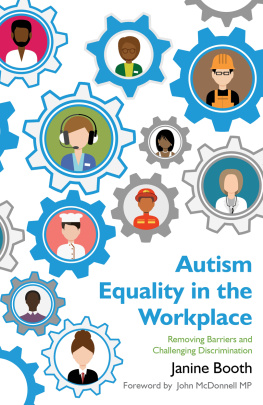
THE
NEURODIVERSE
WORKPLACE
AN EMPLOYERS GUIDE TO MANAGING
AND WORKING WITH NEURODIVERGENT
EMPLOYEES, CLIENTS AND CUSTOMERS
Victoria Honeybourne

CONTENTS
INTRODUCTION
There are many types of flowers daffodils, roses, lilies, daisies, orchids all different and all beautiful. We do not consider any one type of flower superior to any other. We do not try to make the rose more daffodil-like because we consider daffodils the best sort of flower. Flowers are not expected to be the same; this natural variation is accepted and celebrated as part of biodiversity.
There are different types of everything flowers, trees, birds, rocks and, of course, people. Society can be less accepting of that fact. This book considers one specific aspect of human diversity neurodiversity, or the diversity of ways in which humans think, learn and relate to others. Some ways of being (such as those labelled dyslexia, Asperger syndrome or autism, for example) are currently considered inferior to other ways. They are not yet seen as a natural aspect of human variation to be accepted and expected.
Different flowers need different conditions to thrive and flourish. Some need a sunny position; others do best in the shade. Some need regular watering; others survive with very little water. Some grow very quickly; others take their time to flower. Seeds will not grow and thrive if the environment is wrong.
People are the same. Different people flourish in different environments. It makes sense. Our brains all operate differently, so we do not all respond in the same way to the same inputs around us. Unfortunately, our social systems, education systems and workplaces have generally been designed for just one type of person the neurotypical automatically placing any others at a disadvantage.
Work. We might detest office politics and dream of the day a winning lottery ticket means we can spend our days lazing on a beach, but most of us appreciate that work (whether full-time, part-time, self-employment or volunteering) brings more than just financial benefits. Being engaged in some sort of employment contributes to increased self-esteem, independence, social status, a sense of identity and positive physical and mental health. In addition, many people derive pleasure and a sense of satisfaction from what they do. Work when it is the right type for the individual brings meaning, purpose and enjoyment. The right to employment is recognised as a basic human right by the United Nations (UN), yet for many neurodivergent individuals, this remains out of reach.
When growing flowers, we might have limited control over the weather and environment, but workplaces are different. These are systems developed by humans and as such we have total control over them. We can adapt the physical environment, we can change policies, we can adjust the way we communicate. We can recognise that neurodiversity exists and that our existing policies and practices have not been designed to meet the full range of this diversity.
In this book you will learn more about the neurodiversity paradigm and how this can be implemented in the workplace to benefit all colleagues, customers and clients.
AIM OF THE BOOK
The aim of this book is to propose the neurodiversity paradigm as an effective way of approaching the issue of diversity in businesses and organisations in the twenty-first century.
IN THIS BOOK YOU WILL LEARN
what is meant by the term neurodiversity
how neurodivergent individuals interpret the world differently
common difficulties experienced by neurodivergent employees in the workplace
difficulties experienced by neurodivergent customers and clients
the benefits of adopting the neurodiversity paradigm in your workplace or business
employers legal responsibilities relating to neurodiversity
how to communicate more effectively with neurodivergent individuals
how to make policies, practices and physical environments more inclusive
how to empower neurodivergent employees and colleagues, enabling them to thrive in the workplace.
WHO THIS BOOK IS FOR
This book is for anybody who wants to learn more about neurodiversity, the benefits of employing neurodiverse workers in the workplace and how to support neurodivergent individuals. It is for:
managers
employers
human resources (HR) professionals
recruitment specialists
equality and diversity officers
disability and diversity mentors
job coaches
anybody working with neurodivergent colleagues, customers or clients
neurodivergent individuals.
USING THIS BOOK
To learn more about the concept of neurodiversity, begin with , Neurodivergent Individuals then outlines some of the differences and difficulties that neurodivergent individuals can experience. Conditions such as autism, Asperger syndrome, dyslexia, dyspraxia, dyscalculia and ADHD are explained in more detail.
you will learn more about creating inclusive recruitment policies and ensuring that neurodivergent individuals are able to demonstrate their potential.
The next three chapters, Communicating for Neurodiversity, Policies and Practices for Neurodiversity and Neurodiverse-Friendly Environments, explore changes that can be made to workplaces and business environments to make them more inclusive for neurodivergent individuals.
In the final chapter, Working with Neurodivergent Customers and Clients, the focus moves from employees to customers and clients. This chapter discusses some of the difficulties neurodivergent customers and clients can have when dealing with various services, businesses and organisations, and how employers and managers can improve these experiences and retain customers.
In the Further Resources section you will find lists of relevant organisations and publications that can support you further when working with neurodivergent individuals.
TERMINOLOGY
For a detailed discussion of terminology relating to the neurodiversity paradigm, see , Understanding Neurodiversity.
When discussing various neurodevelopmental conditions there are several arguments for using different forms of language. Some individuals prefer identity-first language (e.g., autistic individuals ) and others prefer people-first language (e.g., a person with dyslexia ). This book prioritises ease of reading and therefore uses a variety of these forms. Where possible the word condition has been used to replace disorder (e.g., autism spectrum condition rather than autism spectrum disorder), to reflect that the neurodiversity paradigm does not see different ways of being as disordered, but merely different.
UNDERSTANDING
NEURODIVERSITY
In this chapter you will:
learn what is meant by neurodiversity and the neurodiversity paradigm
learn about various models of disability
understand key terminology relating to neurodiversity
become aware of the increasing recognition of the neurodiversity paradigm in the twenty-first century
recognise the benefits of using the neurodiversity paradigm in the workplace.
WHAT IS NEURODIVERSITY?
NEURODIVERSITY
Neurodiversity = neurological diversity.
Neurodiversity (a term coined by Judy Singer in the 1990s and short for neurological diversity) simply means that there is a range, or diversity, of ways in which human brains function, a range of ways in which we think, learn and relate to others. We do not all think, learn and process information in the same way.
Next page
